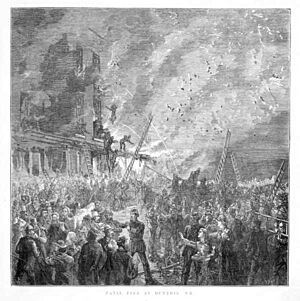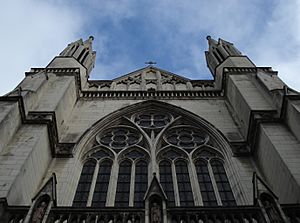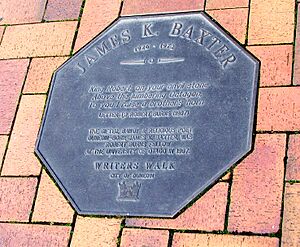The Octagon, Dunedin facts for kids
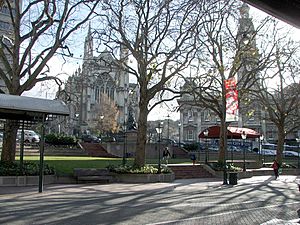
The Octagon is the lively city center of Dunedin, located in the South Island of New Zealand. It's an eight-sided open space with a circular road around it. The city's main street cuts right through the middle. The Octagon is mostly a place for people to walk and relax, with grassy areas and paved paths. A statue of the famous Scottish poet Robert Burns stands proudly in the middle. Many important buildings and places in Dunedin are right next to The Octagon. It's also a main spot for buses and taxis.
The Octagon was first planned in 1846. For many years, it wasn't very developed. But then, the two main parts of the city (north and south of The Octagon) were connected by digging through Bell Hill. From the 1890s onwards, it became the most important central area of the city. The Octagon got a big makeover in the 1980s. Now, it's a popular spot for cafes and restaurants, with many places to eat outside.
Every year, people gather in The Octagon to celebrate New Year's Eve.
Contents
Exploring The Octagon's Location
The Octagon is an eight-sided plaza. It's divided by Dunedin's main street. This street is called George Street to the northeast and Princes Street to the southwest. These two streets are the heart of Dunedin's main business area.
Two other important streets, Upper and Lower Stuart Streets, also end at The Octagon. Lower Stuart Street is shorter. It leads about 600 meters southeast to the Dunedin Railway Station and to State Highway 1. Upper Stuart Street goes steeply uphill to the northwest. It's a major road to the city's hill suburbs and towards the Taieri Plains. A larger octagonal street called Moray Place surrounds The Octagon.
The Octagon is a major hub for public transport. Most bus stops are on the streets leading to The Octagon. There is one main bus stop in the southwest part, near the Reading cinema. In 2018, a new bus hub was built close to Moray Place and Great King Street. This helped reduce some bus traffic directly through The Octagon. Taxi stands are mostly in the northeast part of The Octagon.
What You Can See at The Octagon
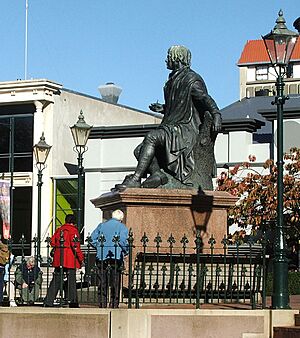
Many important buildings and places in Dunedin are located around The Octagon. Three of these buildings are recognized by New Zealand Historic Places Trust (NZHPT) for their historical value. The Dunedin Municipal Chambers (Dunedin Town Hall), the Civic Centre, and the Public Library are in the northwest part of The Octagon. This area is between George Street and Upper Stuart Street. St. Paul's Anglican Cathedral is also here. Both the Municipal Chambers and the cathedral are very important historical buildings.
In the southwest part of The Octagon, you'll find the Dunedin Public Art Gallery. There's also a movie theater and a large office building called Forsyth Barr House. The southeast part has the Regent Theatre, which is Dunedin's biggest live theater. The Athenaeum and Mechanics' Institute building is also here. This building is being turned into a place for art galleries and studios. The Regent Theatre and the Athenaeum building are also important historical sites. Many cafes and bars are in this area, and also in the northeast part of The Octagon. Lots of these places have outdoor dining areas, making The Octagon a very lively place.
The area inside the main road is a special space for people. The upper part has grass and terraces, and the lower part is paved. A street market often takes place on the paved area once a week. This paved area also has water features and a giant chessboard. Both the paved and grassy areas are often used for outdoor events and performances. At the top of the terrace stands an 1887 statue of the Scottish poet Robert Burns. This statue is also a very important historical item. The poet's nephew, Thomas Burns, was one of the people who helped start the city. The statue is on the McMillan Terrace, which offers a great view of The Octagon.
The Octagon's Past
The Octagon was first planned when Charles Kettle surveyed the city in 1846. His plans for Dunedin's center included a large Octagonal area (Moray Place) with a smaller octagonal space inside. This inner space was meant to be a reserve. This was made official in 1854, six years after the first European settlers arrived. At that time, it was officially called "the Square of Moray Place," but people already called it The Octagon.
Even though it was a reserve, the Anglican Church wanted to build in the center of The Octagon. They asked Governor Sir George Grey directly. The local community, who were mostly Presbyterian, only found out when construction was about to start. This caused a big argument. Otago Superintendent William Cargill was in charge of solving the problem. The Anglicans had to change their plans for The Octagon. Today, the Anglican St. Paul's Cathedral stands at its northern edge.
For many years, The Octagon wasn't well cared for. Early central Dunedin was divided by Bell Hill, which was just south of The Octagon. It was only when a path was cut through the hill, and most of it was removed, that traffic could easily move between the northern and southern parts of the city along Princes Street. This is when The Octagon started to become more important. Still, it didn't look very nice until the 1890s.
The first major structure in The Octagon's reserve area was a monument built in 1864 to remember Cargill. This was moved in 1872 to make way for a central road connecting Princes Street and George Street. In 1887, a statue of the poet Robert Burns was revealed. It still stands at the western edge of The Octagon, near Stuart Street.
On September 8, 1879, a fire broke out in a building called the Cafe Chantant in the lower Octagon. The building was full when the fire started, and it was hard for people to get out. Twelve people died in the fire, including Robert Wilson, who was an editor for the Otago Witness newspaper, and his family. This fire was the biggest loss of life in New Zealand due to fire until a hospital fire 63 years later.
In the early 1890s, several improvements were suggested for The Octagon. These included adding fences and planting trees along the central road. Around this time, a monument was also built for early settler Thomas Burns. However, this monument, built in 1891, was not very popular and was removed in the 1940s. Underground public toilets were put in near the monument in 1910, but these were filled in during the 1970s.
In 1963, the city council received £5,000 from the Evening Star newspaper to build a fountain in The Octagon. This became known as the Star Fountain after it was installed in 1966. It was a popular attraction with lights, music, and water shows that played at certain times. Even though it was popular, it didn't look great when it wasn't playing because of all the visible pipes. When The Octagon was updated in the 1990s, the Star Fountain was removed and not put back, which upset some people.
The Octagon's Big Renovation
In the late 1980s, the Dunedin City Council hired experts to plan a major renovation for The Octagon. The first ideas included closing some roads around and within The Octagon. This caused public protests. In the end, the renovations happened without closing any roads.
The "new look" Octagon actually had an "old look." It featured covered walkways and streetlights designed in an Edwardian style. This gave the city center an antique feel. This design was chosen to match the many beautiful late Victorian and Edwardian buildings around The Octagon.
The improvements also included paving a plaza area in the lower Octagon. This area is now often used for street performances and markets. The renovation of The Octagon, especially adding the plaza, led to more al fresco dining. The Octagon is now a main spot for Dunedin's restaurants and cafes.
The renovation also added two special walks with large plaques in the paving. The bigger one is a "Writers' Walk." It has plaques with words from famous Dunedin writers and words about Dunedin by well-known visiting writers. This walk goes around much of the upper Octagon. A second, smaller walk along the central road of The Octagon has plaques honoring Dunedin-born or -based Olympic medal winners.
Barnes Dance Crossings
In March 2018, special Barnes Dance crossings were added at the southwest and northeast corners of The Octagon. These are intersections where all traffic stops, and pedestrians can walk in any direction, even diagonally. These were the first Barnes Dance crossings in Dunedin for over 20 years. They were a test for a plan to add more such crossings in the city later that year.




